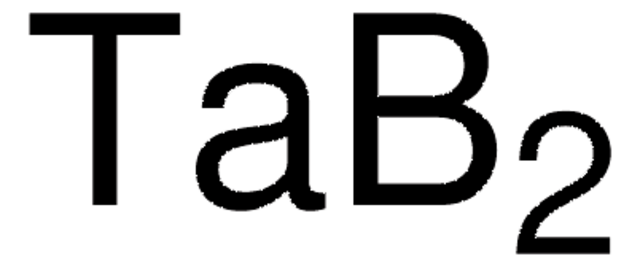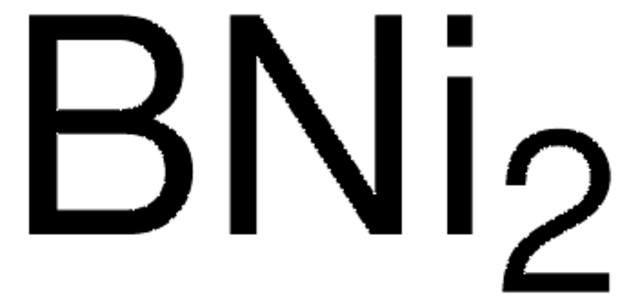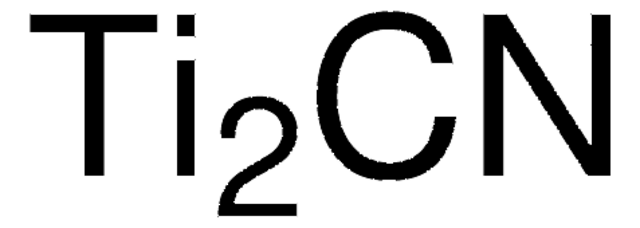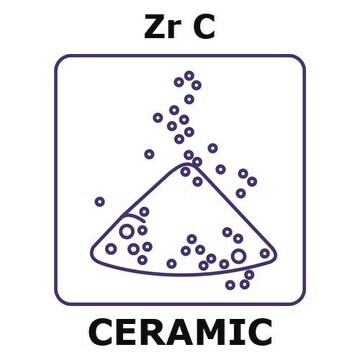About This Item
Fórmula linear:
TiB2
Número CAS:
Peso molecular:
69.49
Número CE:
Número MDL:
Código UNSPSC:
12352300
ID de substância PubChem:
NACRES:
NA.23
Produtos recomendados
Formulário
powder
Nível de qualidade
tamanho de partícula
<10 μm
densidade
4.52 g/mL at 25 °C (lit.)
cadeia de caracteres SMILES
B#[Ti]#B
InChI
1S/2B.Ti
chave InChI
QYEXBYZXHDUPRC-UHFFFAOYSA-N
Categorias relacionadas
Aplicação
- Surface Modifications to Reduce Wear in Hot Extrusion of Copper: Discusses the use of titanium boride in surface treatments to enhance the wear resistance of tools used in the hot extrusion of copper (Thewes et al., 2024).
- Stable DC Vacuum Arc Plasma Generation from a 100 mm TiB2 Cathode: Explores the use of titanium boride in generating stable plasma for coatings, emphasizing its efficiency and stability in industrial applications (Zhirkov et al., 2024).
- Structure Searches and Superconductor Discovery in XB2: Investigates various titanium boride compounds in the context of their structural properties and potential superconductivity applications (Meng et al., 2024).
Palavra indicadora
Warning
Frases de perigo
Declarações de precaução
Classificações de perigo
Acute Tox. 4 Oral
Código de classe de armazenamento
11 - Combustible Solids
Classe de risco de água (WGK)
WGK 3
Ponto de fulgor (°F)
Not applicable
Ponto de fulgor (°C)
Not applicable
Equipamento de proteção individual
dust mask type N95 (US), Eyeshields, Gloves
Escolha uma das versões mais recentes:
Já possui este produto?
Encontre a documentação dos produtos que você adquiriu recentemente na biblioteca de documentos.
Os clientes também visualizaram
Changchun Cao et al.
Huan jing ke xue= Huanjing kexue, 23(6), 108-110 (2003-03-07)
Using 365 nm and 254 nm UV lamp as light source, the degradation of dye X-3B in photolysis, photocatalysis and electrical enhanced photocatalysis was studied in this research. The result shows that the degradation rate of photocatalysis of X-3B was
Yarui An et al.
Chemistry (Weinheim an der Bergstrasse, Germany), 16(48), 14439-14446 (2010-11-03)
α-Synuclein (α-SYN) is a very important neuronal protein that is associated with Parkinson's disease. In this paper, we utilized Au-doped TiO(2) nanotube arrays to design a photoelectrochemical immunosensor for the detection of α-SYN. The highly ordered TiO(2) nanotubes were fabricated
I Dion et al.
Biomaterials, 14(2), 107-110 (1993-01-01)
Ceramics are more and more frequently under consideration for construction of blood-contacting devices, i.e. cardiac valves or cardiac assist devices. This study evaluated the haemolysis eventually initiated in vitro by ceramic powders (Al2O3, ZrO2/Y2O3, AlN, B4C, BN, SiC, Si3 N4
Marta Pegueroles et al.
Biointerphases, 7(1-4), 48-48 (2012-08-10)
An understanding of protein adsorption process is crucial for designing biomaterial surfaces. In this work, with the use of a quartz-crystal microbalance with dissipation monitoring, we researched the following: (a) the kinetics of adsorption on TiO(2) surfaces of three extensively
Pengyu Dong et al.
Nanoscale, 4(15), 4641-4649 (2012-06-22)
Graphene sheets were obtained through solvothermal reduction of colloidal dispersion of graphene oxide in benzyl alcohol. The graphene/rod-shaped TiO(2) nanocomposite was synthesized by this novel and facile solvothermal method. During the solvothermal reaction, both the reduction of graphene oxide and
Nossa equipe de cientistas tem experiência em todas as áreas de pesquisa, incluindo Life Sciences, ciência de materiais, síntese química, cromatografia, química analítica e muitas outras.
Entre em contato com a assistência técnica











